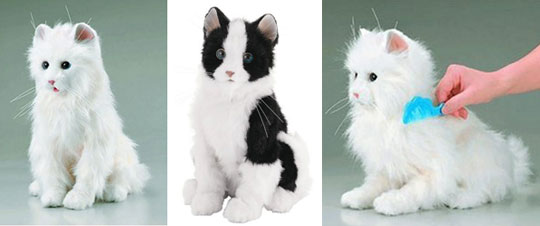Sega Dream Cats - Robocats
Sega Dream Cats - Robocats

SEGA DREAM CATS BY SEGA TOYS. Sometimes, the hassles of owning a pet can outweigh its benefits, especially for people who are allergic, too busy to really look after them, or hate having to clean up a litterbox. Enter robotic pets: although creepy when made too life-like, these furry and feathered creatures are still quite appealing. Especially since they don’t shed or leave anything unsightly on your living room rug.
Sega Toys has been making electronic toys since 2002 (among them “Poo-chi” and “i-Dog”) and in 2007 began a line of robotic pets called the Dream Pet Series. They launched the Dream Cat Smile (Yume Neko Smile) the same year: a 13-inch tall, highly realistic robopet that has both repulsed and completely charmed the public. Still, the Sega Dream Pet Series is highly popular, and has expanded to include chicks, an owl, a kitten, a parrot and a dog.
The Dream Cat Smile is perfect for those who want a real cat but cannot have one. It acts just like a real one, too. Unlike the Furby and Aibo, which seek attention (and sometimes annoyingly so), this one pretty much leaves you alone. Like you would to a real cat, it is up to you whether you want to give it some attention, and even then you have to wait and see if it will take some time out of its queenly existence to respond.
The robot weighs around 4.5 lbs and covered is incredibly soft life-like fur. It can blink, move its mouth and neck, rear up and lie down, and make purring, meowing sounds. If you mistakenly upset it by squeezing its tail, it will even produce hissing sounds. The cat is powered by three C batteries hidden behind a Velcro-covered pocket in its stomach. It has five touch sensors located in different places on its body, allowing you to engage in tactile communication with it. Petting the robocat on its head will make it start purring and flicking its tail. Stroking it on its back makes it sleepy. And if you need to get on with your life and leave Yume Neko alone, it will fall asleep, snore and conveniently settle down into a low-power mode.
The cat is nearly perfect, except for a few downsides such as you can hear the motors whirring inside its body, and unlike the real thing, Yume Neko provides no warmth when you cuddle it. Still, the cat is said to be effective in helping ease tension. A huge percent of robocats owners are patients or senior citizens, who claim that despite its obviously mechanical body, stroking and petting its fur is still relaxing and highly therapeutic.
More recently Sega has come out with a new Sega Dream Cats model named Venus, designed after a Norwegian Forest Cat. Built with a photo sensor on its forehead, this upgraded model can actually sense and react to sound and movement. Sega worked with scientists from Tohoku University‘s Institute of Development, Aging and Cancer in Northern Japan for this to make it even more realistic than Smile. I would say they’ve succeeded. If you say “There, there” to Venus, for example, it will purr, but you have to say it in Japanese. pur
Last year, the company unveiled another robotic cat in the Sega Dream Cats line named Sakadachi Nyachi, their most advanced cat model to date. This one does not look like a real cat. It sports light pink fur and a blue star on its side. It does not act like a real one either. Sakadachi Nyachi follows up to 13 voice commands and can sing while meowing, give a handshake, and even perform a hand stand. This performer cat is a bit creepier than the more realistic one, an uncanny valley in reverse.
So, with all these choices in artificial cats, will anyone be buying or adopting real cats? Will real kitties lose a lot of laps to robopurr? At $100 to $200 Sega Dream Cats cost a whole lot less than a real cat. Now if Sega could only get these catbots to cuddle around and warm your feet on a cold night, and teach them to catch a mouse or two, I think real cats would have to worry. Until then, This author prefers the real feline friends, litter-box, fleas and all.